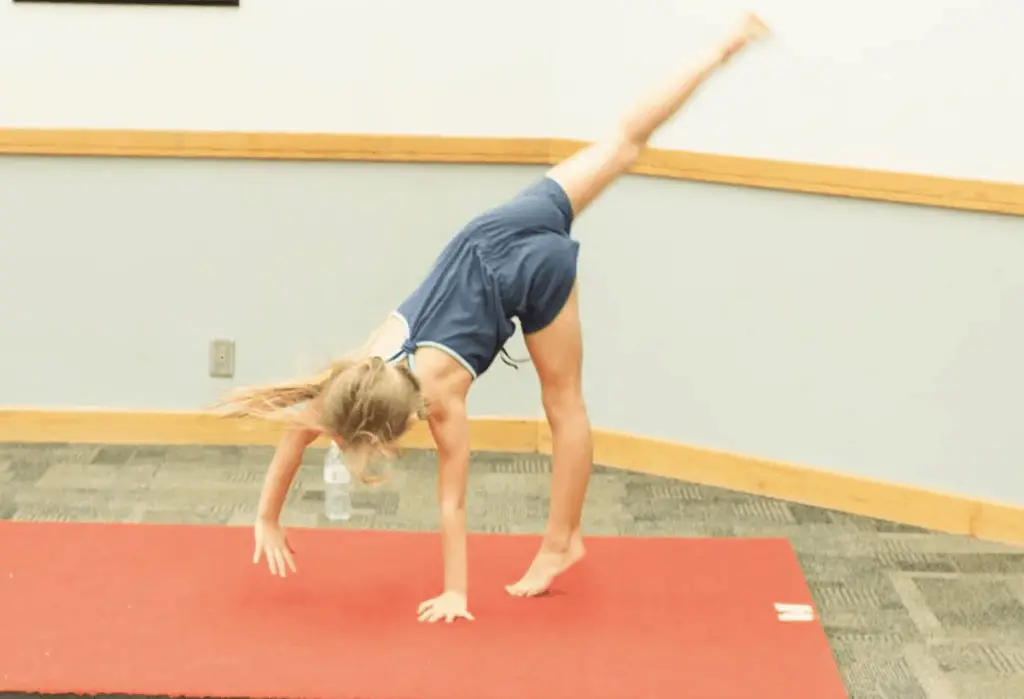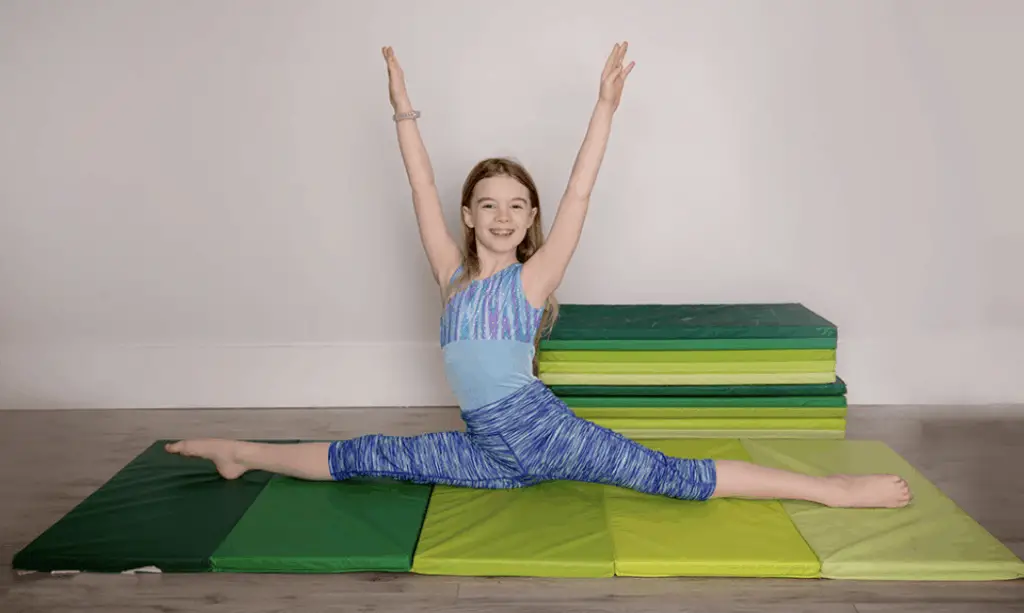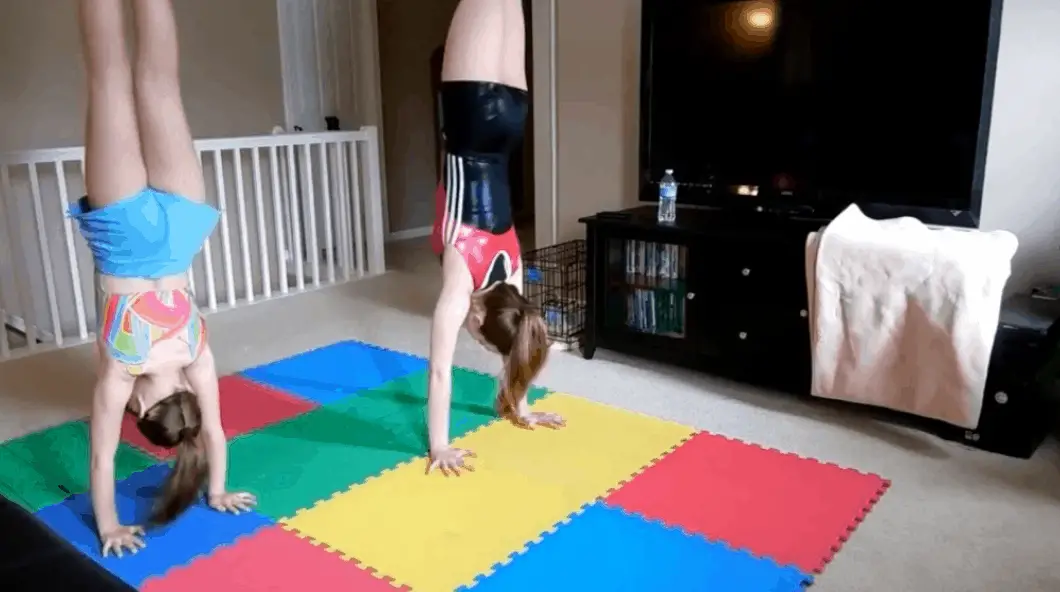Practicing gymnastics at home is something that you need to do, even more so as you get to the higher levels. Even if you do not plan on becoming a pro gymnast, gymnastics is still a great way to stay active and to socialize.
Before we dig in here is a list of the 7 tips we will be covering:
- Give Yourself Enough Space
- Use Mats
- Check Your Equipment
- Don’t Try New Skills Without Approval
- Have Someone To Spot For You
- Be Aware Of Other People And Pets
- Warmup And Don’t Overtrain
If you do plan on taking gymnastics seriously then practicing gymnastics home becomes even more important. However, at the gym there are all kinds of safety equipment which you probably don’t have at home.
Since an injury can keep you from training for weeks, it is vital that you avoid getting injured if you do not want to suffer a setback in your training. That said, these seven safety tips for practicing at home should help you avoid getting hurt.
1. Give Yourself Enough Space
There are many gymnastics moves which take up a lot of space and most of these take up even more space than you think they will, more so when you are first learning how to do them properly. One of the key dangers here is any furniture you might have around.

Unless the only thing in the room is your gymnastics equipment, then you may have coffee tables, tool chests, or any other of the many kinds of furniture in the room with you. Most furniture has some form of an edge to it even if it doesn’t have a sharp corner.
These can be really dangerous if you fall and hit that sharp edge or the knobs on the side of a dresser or anything like that. That is not even mentioning things like glass vases or anything breakable that it should be common sense to have nowhere near where you are practicing at.
It is far better to give yourself too much space than not enough. Try walking yourself through what you plan on practicing, pacing out the area you think it will take you, and then add a foot or so to that in all directions and make sure that there is no furniture or anything in that area.
2. Use Mats
Mats are all over the place in gymnastics gyms for good reason: they help keep you from a ton of bumps and bruises every time you train. If you are going to be doing simple things and tumbling, you can have a thicker mat to offer more cushion.
For the more complicated maneuvers, you may want to have a mat that has less cushion so that the cushion does not interfere. You also want to make sure that your mat is big enough that you do not end up off of the edge of it.
Finally, if your mat is going to be placed on hard or slick floors, you should definitely make sure that it doesn’t slip. This is something else that can be dangerous if you land on it at the end of a salto, for example, and the mat slips under your feet.
3. Check Your Equipment
While this is not something that you would likely think about, this is something that is still very important to do, preferably before every time you practice. If you have things like a balance beam or a bar at your home for you to practice on, you should know that the nuts and bolts can loosen over time.
Since you do not want one side of your bar to get disconnected in the middle of you doing a circling maneuver, you should check the connections and make sure that everything is tight and secure. You do not have to do this every time, but you should do this at least every few times if you want to avoid getting injured do to lose equipment.
On this same note, if your gymnastics equipment that you are practicing on is starting to really show some wear and tear, you should consider replacing it. You do not want to wait until it falls apart with you on it before you replace it.
4. Don’t Try New Skills Without Approval
It might be tempting if you are stuck at home for a while to try to teach yourself that new skill you have been wanting to learn. However, learning a new skill is something that you should only do with your coach there or at the very least you should get their go-ahead.
Your coach not only knows the best ways to build up to a skill, but they will also know how you can do so safely. At the very least, if you cannot make it to the gym, you should talk to your gymnastics coach about what the best way is to learn the skill you want to work on.
Once you get in touch with them, ask them if they think that you are ready to learn the new skill you have in mind and if they think you can handle learning it on your own. If they agree and give you the green light, have a pen and paper ready to take down notes on how they tell you to go about starting to learn it.
5. Have Someone To Spot For You
When you are learning some skills, it is absolutely necessary for you to have someone to spot for you sometimes. This does not need to be someone who is a gymnast, they don’t even have to know the different moves.
If they are not familiar with gymnastics, tell them what they need to do to spot for you and walk them through it. It is better to have someone who may be a little clumsy at helping you than to not have any help at all.
It can be dangerous to try doing a skill you need help with all by yourself. If you get hurt doing it then it can sometimes set you back and take you longer before you get it mastered.
6. Be Aware Of Other People And Pets
While this one might seem like common sense, some things like this simply cannot be overstated. This is especially true if you live in a home where there are a lot of family members coming and going and small pets that might run under your feet.
If possible, you should do your gymnastics training in a room that you can close off and where no one else is. However, this is not always something that it is possible to do which is why you should do your best to be aware.
Small cats and small dogs in particular can be there in a blur of motion that you can easily miss even if you are doing your best to try to keep an eye out for them. In this case, you should ask a family member to keep pets occupied somewhere else.
Siblings that are old enough to understand the dangers should also be old enough to know to take their play elsewhere while a gymnast is training. Toddlers that are too young to understand might require a watchful eye.
7. Warm Up And Don’t Over Train
You no doubt warm up anytime you go to the gym to train and you should always do the same before you practice at home. Even if you only plan on practicing for a short amount of time, you should still take some time to warm up before you get started.

Keep in mind that warming up helps your ligaments and muscles to stretch easier. This, therefore, makes it not only less likely that you will pull a muscle but it also makes it easier for you to succeed at doing whatever it is you are trying to do since your muscles will be more efficient.
You also do not want to overdo your training. This can be particularly easy to do when you are in your own home and your coach is not there to watch you and tell you it is time to move on to something else. So set yourself a timer or something and try not to go over that amount of time.

